Updated February 2025
Your Facebook ad targeting strategy could be better.
That’s not really what most digital marketers want to hear, but nine times out of ten, it’s the truth. Facebook gives us a ton of audience options to choose from, which is great, but using those audiences in an effective and non-self-defeating way is something that takes some thought, knowledge, and skill. One foundational method is using core audiences, which allows you to classify users based on demographics, interests, and behaviors.
You have to
- know what all your audience options are
- know what purpose each serves in your funnel
- know the right balance between them
- find the right audiences that are interested in your product
- know how to optimize them in a way that gets more results for less cost
All those things can be mind-boggling if you’re just starting out. Heck, they can be mind-boggling for experienced folks, too.
Facebook is a complex organism, and assuming that it’s faster to throw together a build and get started on Facebook than it is on Google Ads is actually where a lot of Facebook problems start.
In this article, we’ll help prevent those Facebook ad targeting troubles by detailing the three essential Facebook ad targeting options every expert advertiser should take advantage of in their Facebook ad campaign. We’ll also help you figure out how to remedy existing Facebook issues with six nuggets of ad targeting optimization wisdom.
By the time you finish reading, you’ll have trimmed the broad vagueness from your Facebook PPC ads and turned them into tight, streamlined, budget-loving conversion goldmines
Hoist your pickaxes, Facebook ad miners. Let’s get right to it.
Get brand new Facebook ad strategies straight to your inbox every week. 23,739 people already are!
- The 3 essential types of Facebook ad targeting
- Finding insights on your audiences
- 6 optimization tips to clean up your Facebook ad targeting strategy
- Closing thoughts on Facebook ad targeting
Understanding Facebook Ad Targeting
Facebook ad targeting is a powerful tool that allows businesses to reach their desired audience with precision. With over 2.7 billion monthly active users, Facebook offers a vast pool of potential customers. However, with so many users, it can be challenging to reach the right people. That’s where Facebook ad targeting comes in. By using Facebook’s targeting options, businesses can ensure that their ads are seen by people who are most likely to be interested in their products or services.
Facebook ad targeting works by using various criteria to narrow down the audience. This can include demographic information such as age, location, and interests, as well as behaviors and connections. By targeting the right audience, businesses can increase the effectiveness of their ads and drive more conversions. Facebook offers a range of targeting options, from broad demographic targeting to highly specific custom audiences, allowing businesses to tailor their campaigns to meet their unique goals.
What’s the Difference Between Google Ads and Facebook Ads?
The core difference lies in how audiences are targeted:
- Google Ads targets people actively searching for your products or services using specific keywords. Because new people enter and leave this audience continuously, ad fatigue is less of an issue.
- Facebook Ads targets a static audience based on demographics, interests, and behaviors. This audience doesn’t change much, leading to quicker ad fatigue and audience decay as engagement drops over time.
So, which platform is better? It depends:
- Use Facebook Ads if your product thrives on a visual, engagement-driven platform.
- Use Google Ads if you need a higher-intent platform to drive quick conversions.
The best results often come from combining both platforms in your strategy.
On Facebook, you must evolve your targeting strategy regularly to guard against ad fatigue and audience decay. Facebook Ads Manager can be used to create and manage targeted advertising campaigns, including building custom audiences and leveraging lookalike audiences. Running multiple campaigns with diverse targeting approaches creates a dynamic funnel, allowing users to move through your marketing pipeline efficiently.
As Facebook thought leader, Mari Smith puts it:
“The best Facebook ads look and feel as relevant and timely in your News Feed as the posts you see from your friends.”
By keeping your Facebook marketing ads relevant, timely, and well-targeted, you’ll cut through the noise and ensure your campaigns resonate with the right audience. Facebook’s robust targeting tools—whether for broad demographics, niche interests, or custom audiences—are designed to help you achieve this. Just make sure you fully understand ANY/ALL targeting rules (or OR/AND targeting) to use these tools effectively.
ANY vs. ALL (OR vs. AND) Targeting Rules in Facebook Ads
Facebook’s targeting rules dictate how multiple criteria in your audience are applied, and understanding these rules is crucial for effective targeting: Facebook targeting involves sophisticated advertising strategies to effectively reach specific audiences.
ANY Targeting (OR Targeting)
- How it works: Your audience expands because users only need to meet one of the selected criteria.
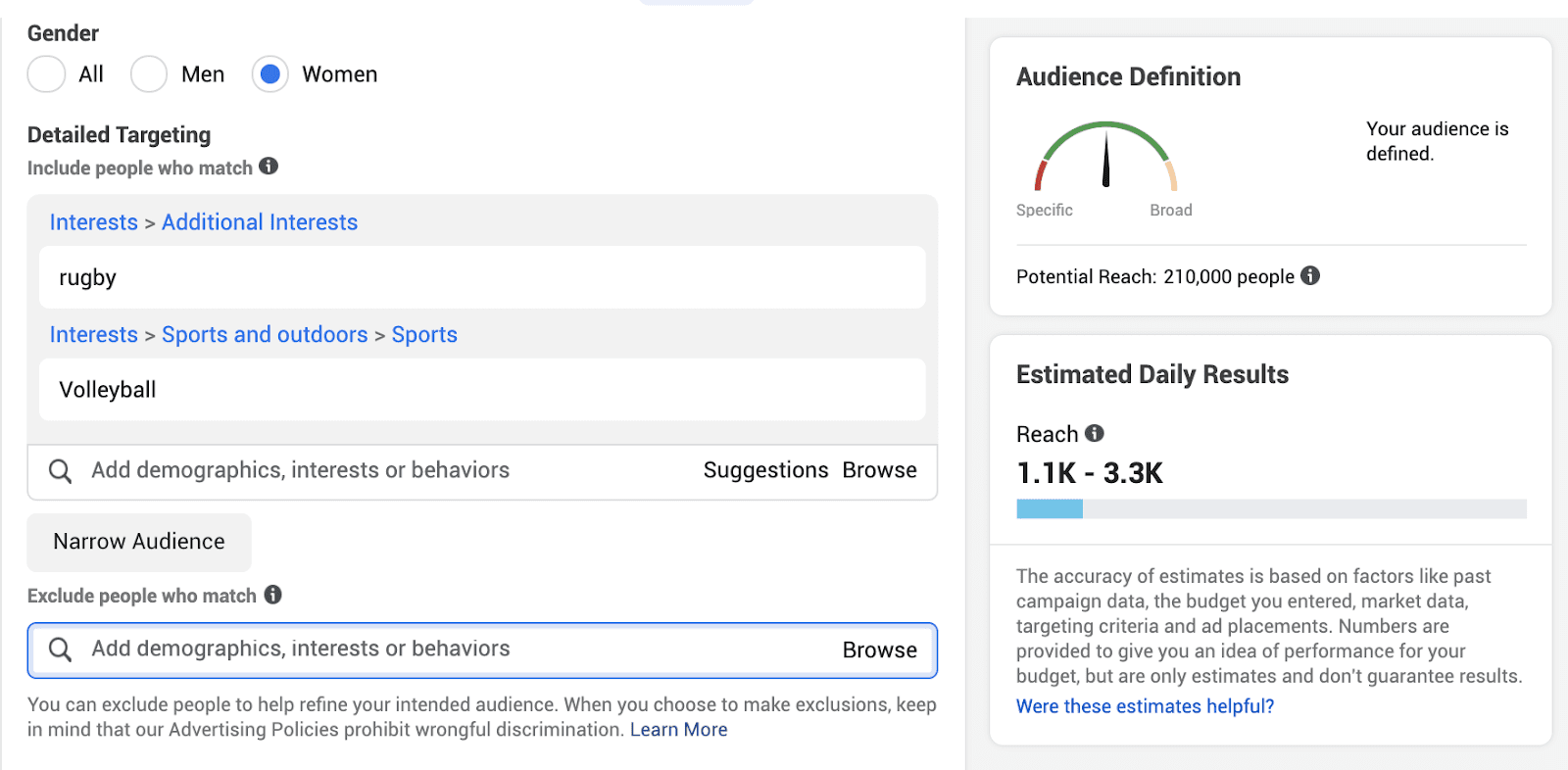
- Example: If you target “women who like rugby OR volleyball,” Facebook will include anyone who likes either rugby or volleyball
This approach is great for top-of-funnel campaigns when you’re prospecting and want to cast a wider net.
ALL Targeting (AND Targeting)
- How it works: Your audience narrows because users must meet all the selected criteria.
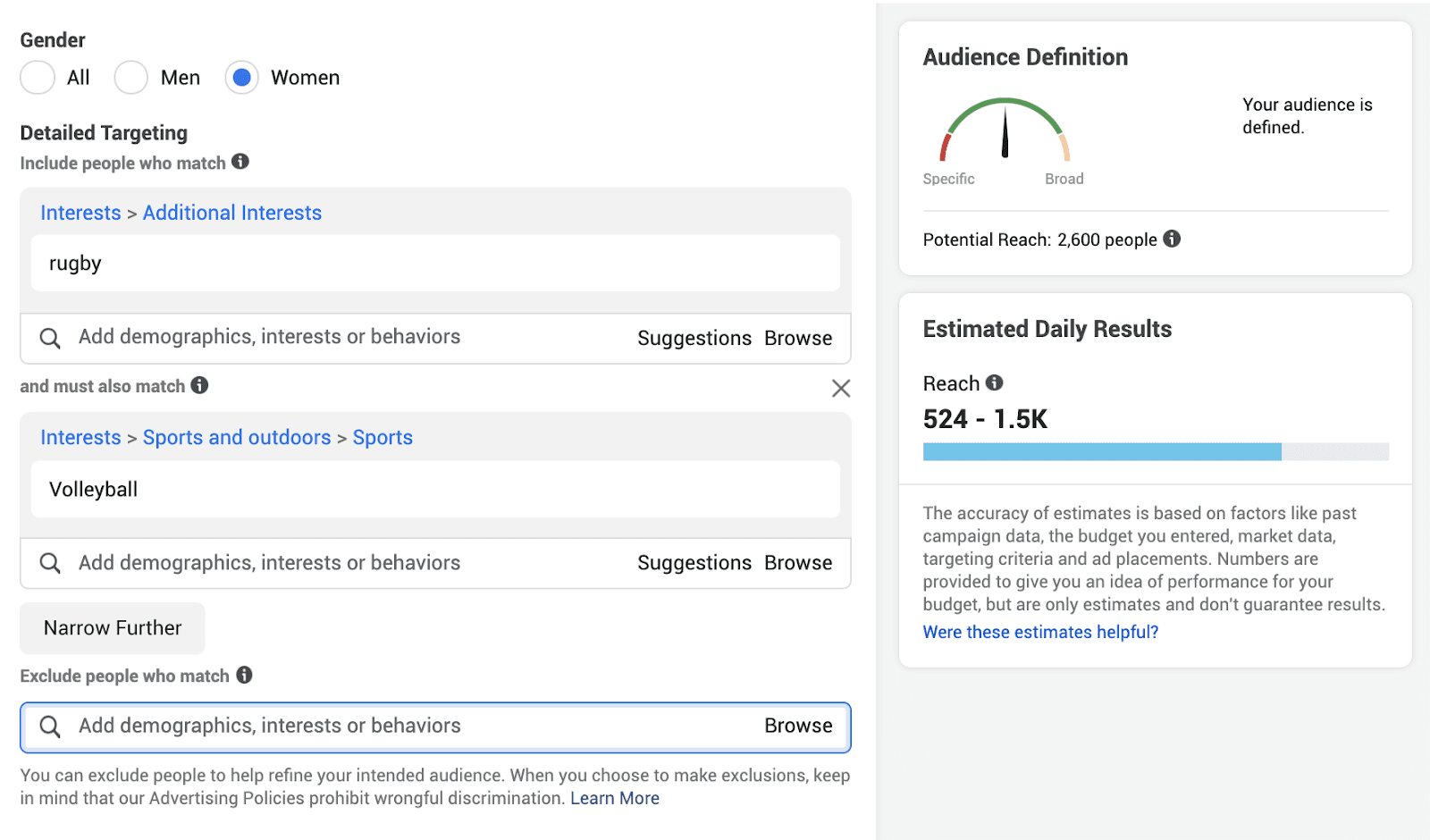
- Example: If you target “women who like rugby AND volleyball,” Facebook will only include people who like both rugby and volleyball.
This is ideal for bottom-of-funnel campaigns, as it helps refine audiences to target people with higher intent.
Excluding Audiences
Exclusions allow you to remove specific groups from your targeting. This prevents inefficiencies like showing ads to people who’ve already converted or are no longer relevant.
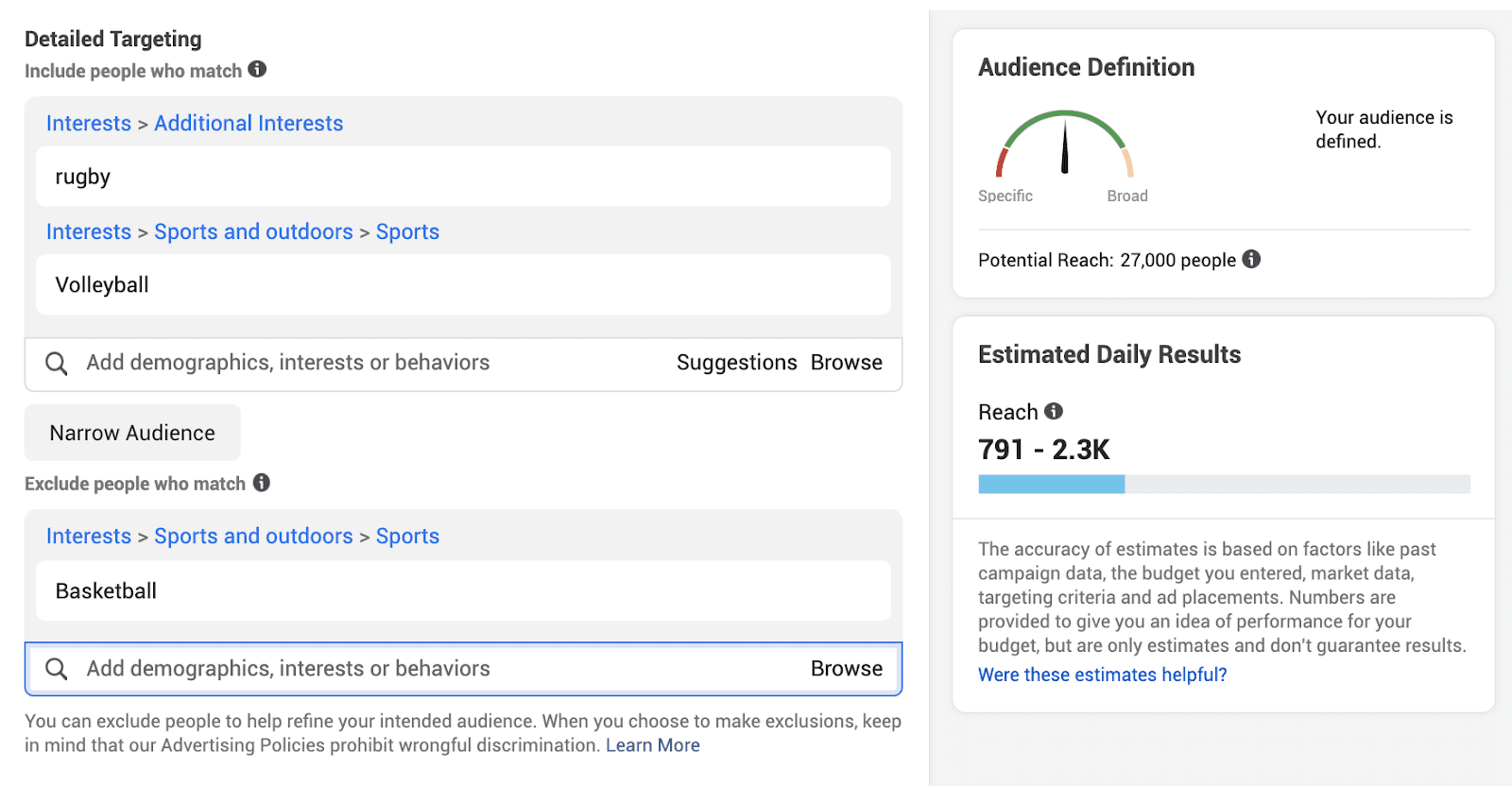
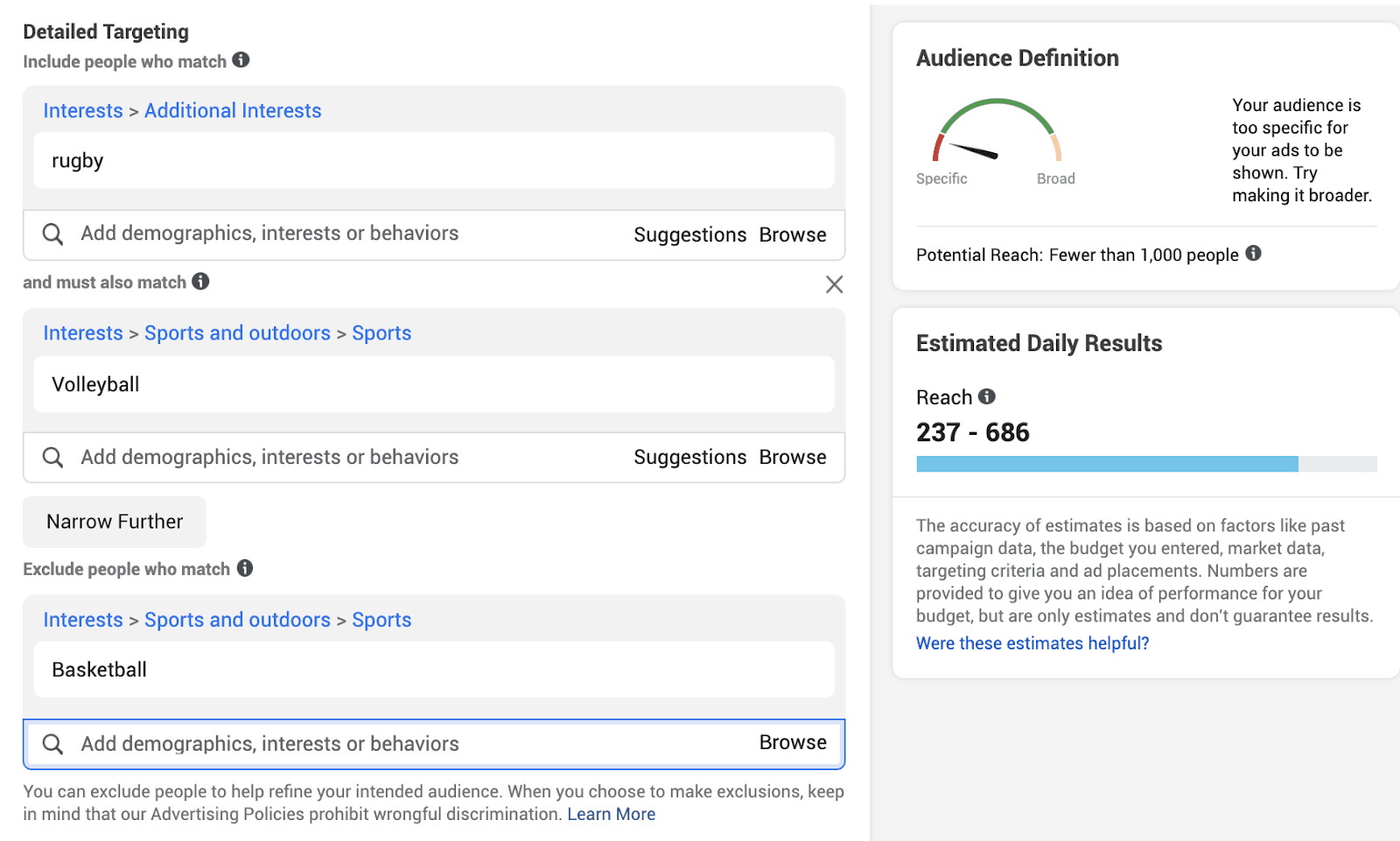
- Example: INCLUDE Women who like both rugby and volleyball, but EXCLUDE women who like basketball
Exclusions are especially useful for managing audience overlap and reducing ad fatigue. For example, if a user is in your retargeting audience, you’ll want to exclude them from your prospecting audience to avoid showing them cold offers. Businesses are able to create custom audiences based on user interactions, such as those who have added items to a shopping cart without completing a purchase, to enhance advertising efficiency and conversion rates.
6 Facebook Ad Targeting Tips for Success
1. Detailed Targeting Audiences
Detailed targeting is a top-of-funnel strategy for connecting with broader, colder target audiences. This feature allows advertisers to segment their audience based on demographics, interests, and behaviors. Combining various targeting strategies and demographics is crucial to reach specific segments effectively. Demographics include attributes like education, relationship status, and parental status, while interests cover hobbies and activities, such as fitness, entertainment, and business. Behavioral targeting hones in on actions like travel habits or device usage.
For instance, if you sell vintage video games and want to promote a buy-one-get-one-free birthday offer, target users with upcoming birthdays who are also interested in video games. Combining these targeting layers ensures your audience is more specific and relevant. To further refine your targeting, use the Meta Pixel to track website visitors and segment them for follow-up campaigns. Offering low-barrier options, like free trials or downloadable resources, is an effective way to engage these audiences.
Demographic and Interest Targeting
Demographic targeting allows businesses to target their ads based on demographic information such as age, location, and interests. This is useful for businesses that want to reach a specific age group or location. For example, a business that sells clothing for young adults may want to target people aged 18-24 who live in urban areas. By honing in on these specific demographics, businesses ensure their ads are relevant and engaging to the right audience.
The demographic audience subcategories currently available include
- education (education level)
- financial (income percentile)
- life events (like birthdays and anniversaries)
- parents (parental status)
- relationship (relationship status)
- work (employers, industries, or job titles)
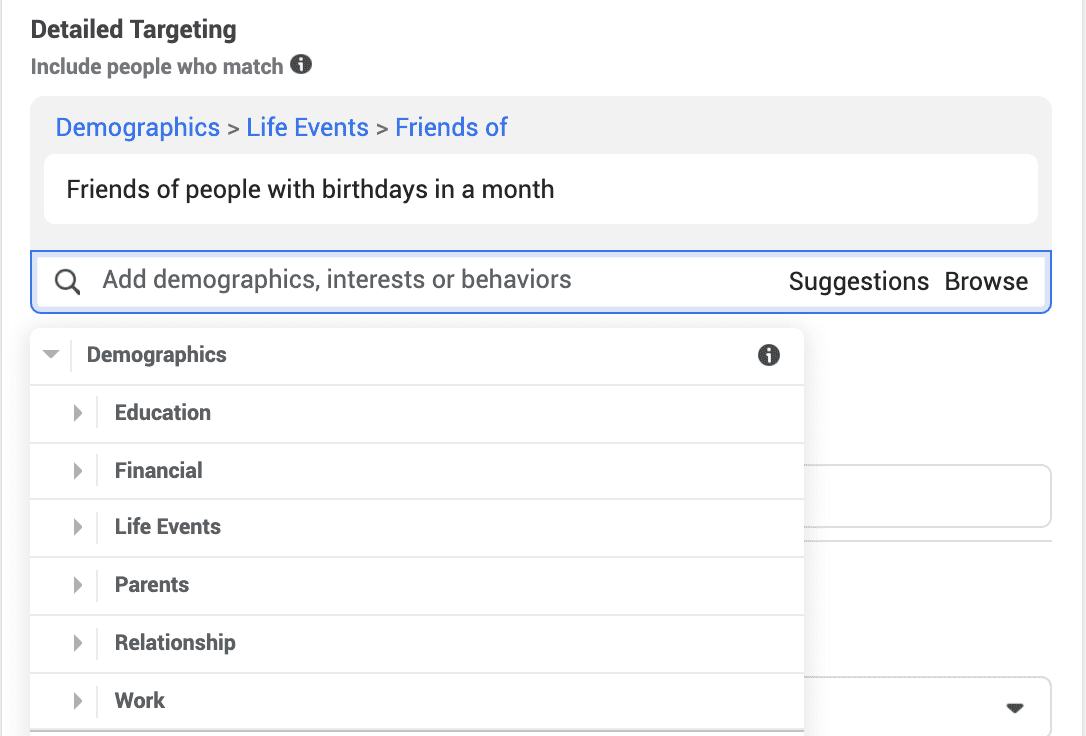
Demographics subcategories
Outside of detailed targeting, there are even more broad demographics audience targeting options you should consider working with. These include
- location (where someone is located)
- age range (what age someone is)
- gender (what gender they identify as)
- language (what language their browser is set to)
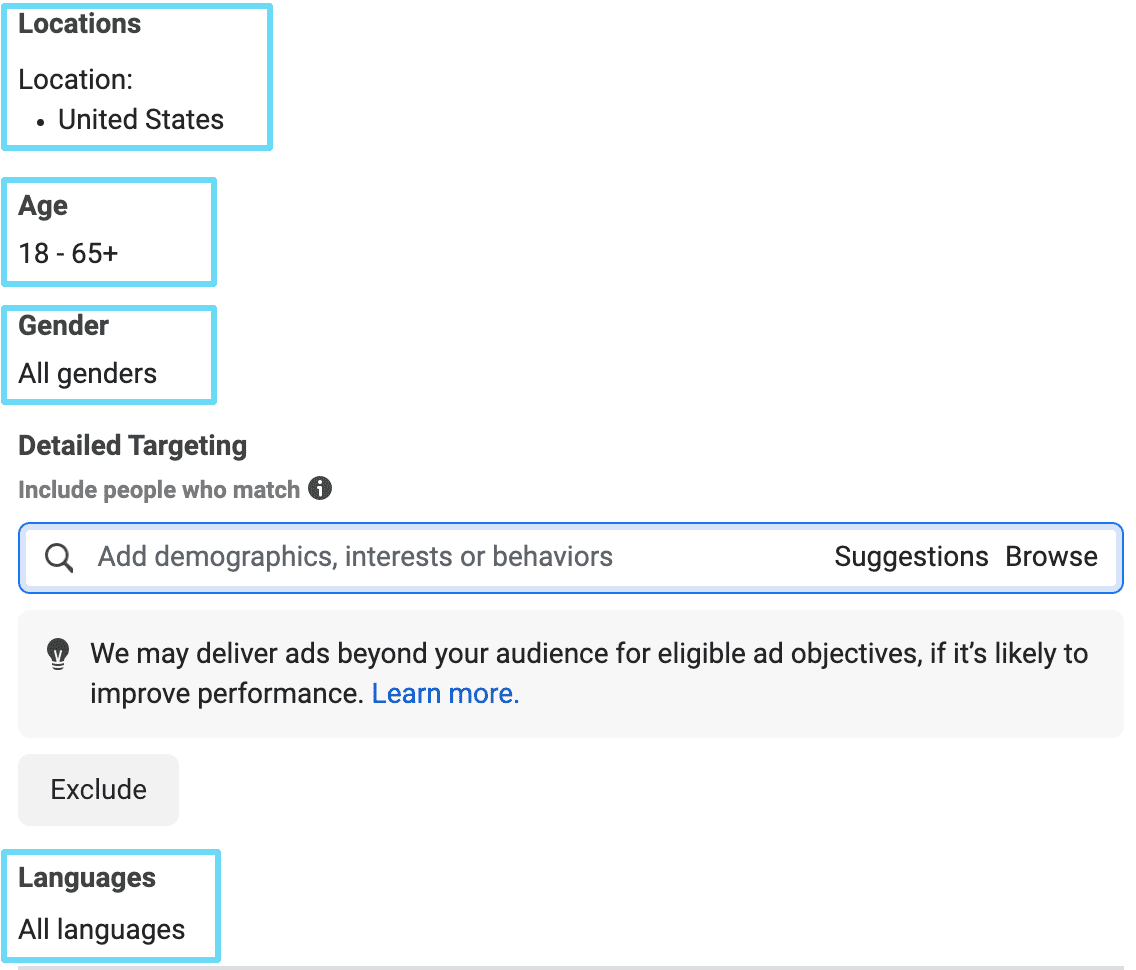
Other demographic targeting options available
They're not technically a part of detailed targeting, but they are still an important part of your demographic tailoring. At the very least, you should be narrowing down your location targeting specific countries, states, or cities. (No one really benefits from—or has enough budget for—targeting the whole world.)
Interest targeting, on the other hand, allows businesses to target their ads based on people’s interests. These are useful for businesses that want to reach people who are interested in specific hobbies or activities. For example, a business that sells outdoor gear may want to target people who are interested in hiking or camping. By aligning their ads with the interests of their target audience, businesses are ableto create more personalized and compelling ad experiences.
Just to give you a taste (we'll let you do the rest of the exploring), some of the sub-categories available under “Interests” are
- business and industry
- entertainment
- family and relationships
- fitness and wellness
- food and drink
- hobbies and activities
Plus many more, all of which have a list of their own sub-sub-categories.
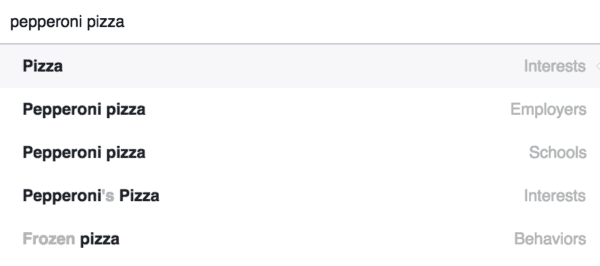
I want to target pepperoni pizza lovers, not the pepperoni pizza school
2. Custom Audiences
Custom audiences target users who have already interacted with your brand, making them highly effective for retargeting and middle-to-bottom-of-funnel campaigns. These audiences can be created using off-Facebook data, such as website activity, app engagement, or uploaded customer lists, and on-Facebook data, like video views, lead forms, and Instagram interactions.
With custom audiences, you're able to upload and/or connect your own data to identify your prospects on Facebook and Facebook's Audience Network. This is where our strategy goldmines, retargeting audiences, are born.
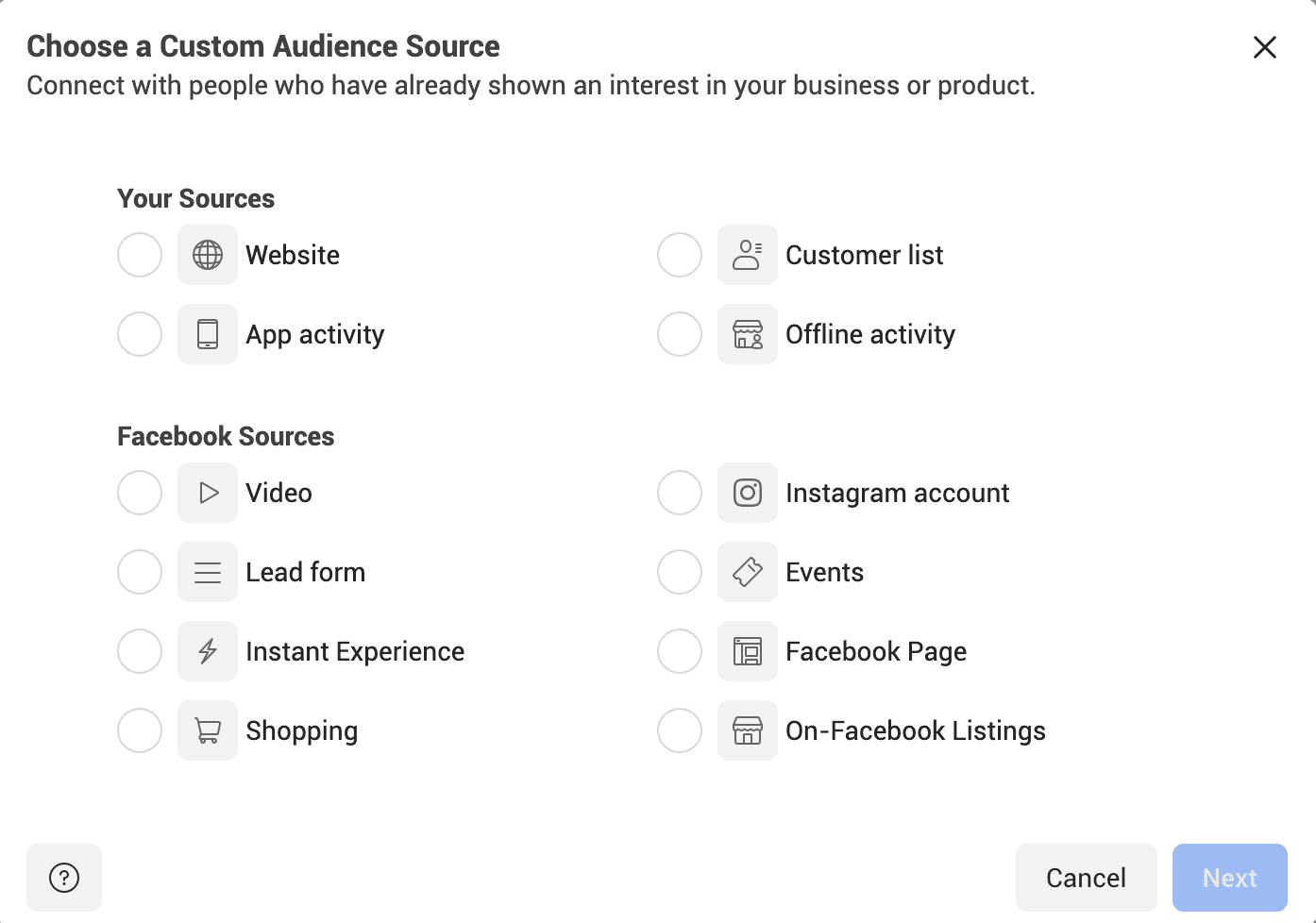
Custom audience targeting options
For example, if someone visited your pricing page but didn’t complete a purchase, you could retarget them with ads showcasing a limited-time discount. Another example involves targeting users who watched 75% or more of a product demo video, signaling a strong interest in your offer. These audiences are proven to drive higher ROAS because they already have intent. A great success story is Feeling Swell, which saw a 521% increase in purchases and a 108% boost in ROAS by focusing on retargeting custom audiences.
3. Lookalike Audiences
Lookalike audiences are a game-changer for scaling your campaigns. These allow you to reach new users who share similarities with your existing customers or engaged audiences. For example, you can create a Lookalike audience based on your previous converters or website visitors. Facebook uses its algorithm to identify people with similar behaviors, interests, and demographics.
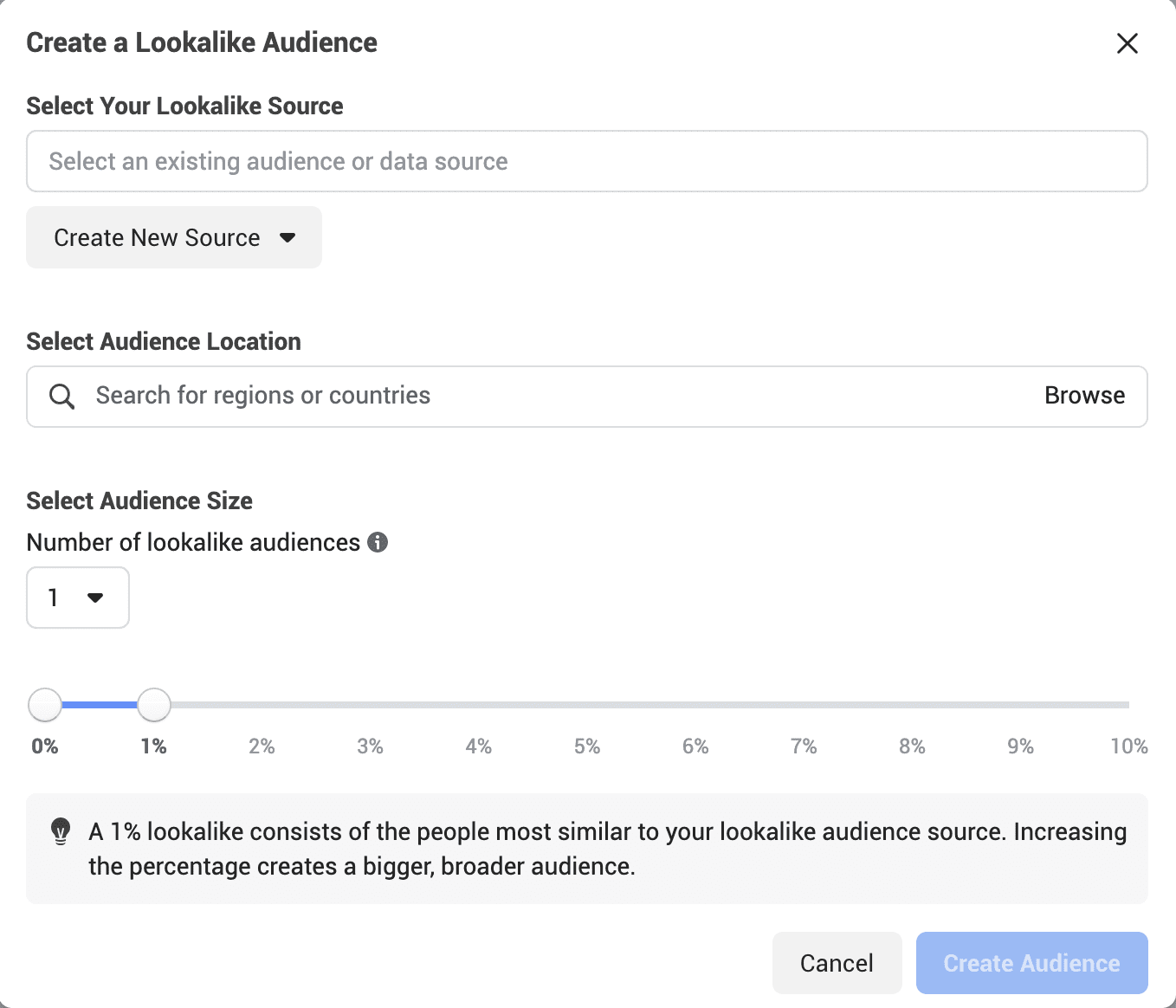
Lookalike audience setup
Facebook Custom Audiences allow marketers to retarget website visitors, utilize customer data, and refine their audience based on various demographic factors to enhance engagement and increase sales.
A great example is building a Lookalike of your lead submitters, which often results in significantly lower CPA and higher conversion rates compared to interest audiences. For instance, one client achieved a 49% lower CPA and 66.67% more conversions with a lead submitter Lookalike audience. You can also create Super Lookalike audiences, such as combining 0%–1% and 1%–5% ranges, to test broader but still relevant segments. One client, GATA, tested this strategy and saw a massive 3,339% increase in conversions.
Finding Insights on Your Audiences
Understanding your audience is vital for creating impactful campaigns. The updated Insights tool in Ads Manager provides data on the demographics, locations, and behaviors of your current and potential audiences. This tool helps you identify high-performing segments and refine your targeting strategy accordingly.
For example, you might discover that your highest-converting audience skews toward women aged 25–34 who live in urban areas and frequently engage with fitness-related content. Insights like these will help guide your creative direction and inform which targeting options to prioritize. Additionally, if your campaigns aren’t performing as expected, revisit these insights to identify mismatches between your audience attributes and ad placements. While the data is valuable, it’s important to test and validate findings with actual campaign performance to ensure relevance.
4. Separate Your Audience Funnels by Campaign
Keeping prospecting, re-engagement, and retargeting audiences in separate campaigns is essential for maintaining control and preventing self-competition. Mixing these audiences in the same campaign often leads to overlaps, higher CPMs, and muddled performance data. Separating them ensures clarity in your strategy and allows for more precise budget allocation.
Utilizing Facebook audience insights for targeted advertising is crucial. Tools like Google Analytics and Meta Business Suite Insights help gather demographic and interest data, enabling marketers to refine their Facebook audience for improved ad targeting and to strategically target competitors' customers.
For instance, prospecting campaigns focus on detailed targeting and Lookalikes, while re-engagement campaigns target video viewers or Instagram engagers. Meanwhile, retargeting campaigns deliver tailored offers to past website visitors or lead form completions. This separation simplifies optimization and ensures each audience is getting the right message at the right stage of your funnel. Additionally, using Campaign Budget Optimization (CBO) at the campaign level ensures your budget is allocated effectively across these funnels.
5. Separate Lookalikes from Detailed Targeting at the Campaign Level
Lookalike audiences and detailed targeting audiences should each have their own campaigns to maximize performance. Lookalikes are typically larger and demand more of your budget, whereas detailed targeting audiences are more niche and benefit from a dedicated budget to test their potential. Combining the two into one campaign often results in Lookalikes dominating the budget and detailed targeting getting sidelined.
For example, if you’re running a campaign for rugby fans, use one campaign to target Lookalikes based on previous converters and another campaign to test detailed interest targeting, such as people interested in specific rugby teams. This approach helps you accurately measure the performance of each targeting method. Allocating separate budgets ensures you optimize effectively without one audience cannibalizing the other. Additionally, users can manage your ad experience through specific settings within their platforms, adjusting ad preferences and settings to control the data used to show personalized ads.
6. Allocate Your Budget More Heavily Toward Prospecting
Many advertisers are tempted to pour their budget into retargeting campaigns because they generate the most conversions. However, without consistent prospecting traffic to feed into your retargeting lists, those audiences will dry up, leading to ad fatigue and diminishing returns. A healthy allocation typically involves dedicating 60–70% of your budget to prospecting and 15–25% to retargeting.
For instance, one client adjusted their budget to focus more on prospecting traffic and saw a 400% increase in conversions and a 54.69% decrease in CPA within just seven days. Dynamic Creative Ads are also an excellent tool for prospecting, as they test multiple variations of creative elements (e.g., images, headlines, and calls-to-action) to find what resonates best with new audiences. By keeping prospecting audiences fresh and robust, you set the foundation for sustainable retargeting performance. Cookies from other companies are used to show you ads based on your activity across various platforms, allowing users to control and personalize their ad settings.
Your Facebook ad targeting is the foundation of your strategy, and without solid ad targeting sense, you can easily flop on Facebook.
Now that you’ve got a good idea of what’s involved in selecting your audiences and what your options are, you’re more prepared to build a killer Facebook strategy and succeed with your Facebook ad campaigns.
And while you’ve got all that ad targeting knowledge bubbling in your brain, it’s a good time to learn the other part of your audience targeting strategy: where your ads show in Facebook ad placements.
FAQs for Facebook Ad Targeting
1. How does Facebook ad targeting help businesses connect with potential customers?
Facebook ad targeting uses demographics, interests, and behaviors to identify potential customers most likely to engage with your products or services. By leveraging tools like the Meta Pixel, businesses can track website visitors and create custom audiences for retargeting. For instance, targeting users interested in "fitness and wellness" or "life events" aligns your ads with relevant audiences, improving conversions and ROI.
2. What are Lookalike Audiences, and how can they benefit your campaigns?
Lookalike Audiences allow businesses to expand their reach by targeting new users who share similarities with existing customers or leads. For example, creating a Lookalike based on website visitors or past purchasers helps identify people with shared interests and behaviors, often reducing CPA and increasing engagement. This method is ideal for scaling campaigns while maintaining relevance.
3. What is the role of cookies in Facebook ad targeting?
Cookies and similar technologies track user behavior to enhance ad relevance. Facebook uses them to provide features like maps and tailor ads for specific audiences. However, stricter privacy rules like iOS updates have impacted cookie effectiveness. Tools like the Conversions API ensure advertisers can still gather valuable data while users can manage cookies through browser settings or opt out of optional cookies.
4. How do detailed targeting and custom audiences differ?
Detailed targeting focuses on broader, top-of-funnel users based on demographics like age or interests. Custom audiences, however, re-engage users who have already interacted with your brand, such as app users or website visitors. Combining these strategies ensures businesses attract new prospects while retaining engaged customers.
5. What makes Facebook ad targeting unique compared to Google Ads?
Facebook targets users based on interests and demographics, perfect for visually driven campaigns, while Google focuses on search intent. Businesses often combine both for maximum impact, using Facebook to drive awareness and Google to capture high-intent leads.
